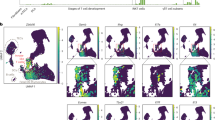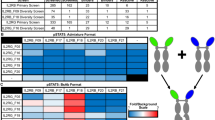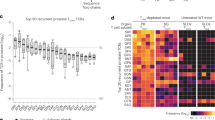Abstract
T3-associated disulphide linked heterodimers (Tin) comprised of clonally unique α-chains of molecular weight (MW) 49,000–54,000 and β chains of MW 43,000 have been identified as the antigen receptors on human cytotoxic effector and inducer T-lymphocytes1–3. Crosslinking of Ti molecules by either the appropriate nominal antigen/MHC specificity or anti-clonotypic monoclonal antibody results in clonal expansion of such cells via induction of IL-2 receptor expression, endogenous IL-2 release and IL-2-IL-2 receptor interaction4. To determine whether analogous antigen receptor molecules and autocrine growth mechanisms are utilized by suppressor T-cells5–7, we produced an anti-clonotypic monoclonal antibody against a non-cytotoxic T8+ suppressor T-cell, T8AC6, which defines a T3-associated disulphide-linked heterodimer of similar molecular weight to the above clonotypes. We find that T3-Ti triggering of suppressor clones (T8AC6, T8AC7 or T8RW) does not result in IL-2 production or T-cell proliferation and in contrast to inducer clones, also leads to a transient IL-2 unresponsive state. We suggest that such T3-Ti receptor mediated autoregulation of suppressor T-cell growth is necessary in the facilitation of initial inducer T-cell activation following antigenic perturbation.
This is a preview of subscription content, access via your institution
Access options
Subscribe to this journal
Receive 51 print issues and online access
$199.00 per year
only $3.90 per issue
Buy this article
- Purchase on SpringerLink
- Instant access to full article PDF
Prices may be subject to local taxes which are calculated during checkout
Similar content being viewed by others
References
Meuer, S. C. et al. Nature 303, 808–810 (1983).
Acuto, O. et al. J. exp. Med. 158, 1368–1373 (1983).
Meuer, S. C. et al. Science 222, 1239–1242 (1983).
Meuer, S. C. et al. Proc. natn. Acad. Sci. U.S.A. 81, 1509–1513 (1984).
Cantor, H. F. et al. J. exp. Med. 143, 1391–1401 (1976).
Fresno, M. et al. J. exp. Med. 153, 1246–1259 (1981).
Sy, M. S. et al. J. exp. Med. 153, 1415–1421 (1981).
Bensussan, A. et al. J. exp. Med. 159, 559–576 (1984).
Kohler, G. & Milstein, C. Nature 256, 495–497 (1975).
Meuer, S. C. et al. J. exp. Med. 157, 705–719 (1983).
Reinherz, E. L. et al. Eur. J. Immun. 10, 570–572 (1980).
Gershon, R. K. et al. J. exp. Med. 153, 1533–1546 (1981).
Green, J. R. et al. Eur. J. Immun. 11, 973–986 (1981).
Tanaguichi, M., Takei, I. & Tada, T. Nature 283, 227–228 (1980).
Kapp, J. A., Sorensen, C. M. & Pierce, C. W. Prog. Immun. 5, 871–880 (1983).
Benacerraf, B. & Germain, R. N. Immun. Rev. 38, 70–119 (1978).
Lamb, J. R. & Feldman, M. Nature 300, 456–458 (1982).
Reinherz, E. L. et al. J. Immun. 128, 463–468 (1982).
van Agthoven, A. C. et al. Eur. J. Immun. 11, 18–21 (1981).
Author information
Authors and Affiliations
Rights and permissions
About this article
Cite this article
Bensussan, A., Acuto, O., Hussey, R. et al. T3-Ti receptor triggering of T8+ suppressor T cells leads to unresponsiveness to interleukin-2. Nature 311, 565–567 (1984). https://doi.org/10.1038/311565a0
Received:
Accepted:
Issue date:
DOI: https://doi.org/10.1038/311565a0
This article is cited by
-
Cloned suppressor T cells from a lepromatous leprosy patient suppress Mycobacterium leprae reactive helper T cells
Nature (1986)
-
Genetically restricted suppressor T-cell clones derived from lepromatous leprosy lesions
Nature (1986)
-
Rearrangement and transcription of the β-chain genes of the T-cell antigen receptor in different types of murine lymphocytes
Nature (1985)
-
Homology of Ti α-subunit of a T-cell antigen–MHC receptor with immunoglobulin
Nature (1984)



